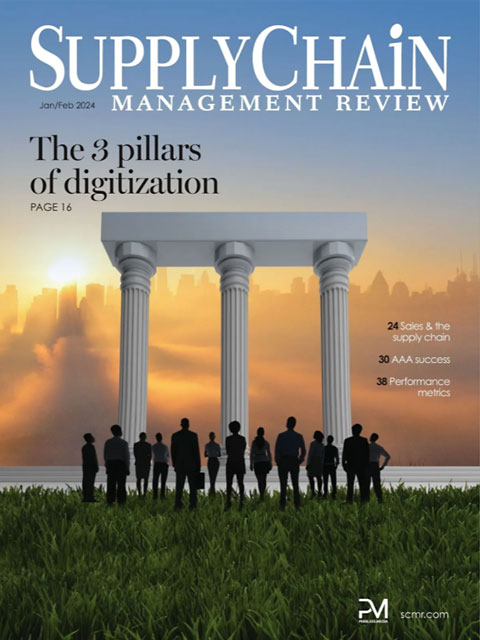Sorry, but your login has failed. Please recheck your login information and resubmit. If your subscription has expired, renew here.
January-February 2024
Back in 2019, we seemed on a consistent path to the future. Then COVID-19 arrived on the global scene, and all predictions went out the window. As 2024 begins, everyone wants to know what the year will look like. I predict continued interest in circular supply chains, cybersecurity, visibility, and digital supply chains, to name a few. But I am not alone. So, I’d like to share five things that I am particularly interested in this year. Browse this issue archive.Need Help? Contact customer service 847-559-7581 More options
Performance metrics play a critical role in the planning and management of a firm’s supply chain operations and network. Today, firms employ an ever-increasing array of dashboards, scorecards, and key performance indicators (KPIs), all of which provide perspective on both the efficiency and effectiveness of a firm’s internal operations and its external interactions with customers and suppliers.
At the same time, and with far less publicity and general industry awareness, a second type of supply chain status measures have emerged and flourished. We will term these “macro indicators” that offer a perspective not at the “individual firm” level, but rather at much broader macro levels such as international transportation lanes (e.g., China to the United States), geographic regions (e.g., the United States, Germany, and Asia), and other groupings. These macro indicators vary widely, appear in many different forms, and utilize different methodologies. However, they share the common characteristic of offering an evaluation of some aspect of supply chain operations that will generally affect many firms across many industries. Finally, we note that many of these measures have existed for decades in relative obscurity, while others represent more recently created tools developed in response to the supply chain disruptions associated with the recent pandemic.
In this article, we will first discuss individual firm supply chain performance metrics, and then consider supply chain macro indicators. Our discussion of firm-level metrics presents a general framework that a supply chain organization can employ to house its performance measures. The macro indicator discussion that follows afterward highlights both the global as well as the narrower perspectives these measures can offer about particular supply chain activities, transportation modes and geographic regions. Finally, we will present and illustrate approaches supply chain professionals and their firms can utilize to integrate these two disparate forms of metrics.

This complete article is available to subscribers only.
Log in now for full access or start your PLUS+ subscription for instant access.
SC
MR
Sorry, but your login has failed. Please recheck your login information and resubmit. If your subscription has expired, renew here.
January-February 2024
Back in 2019, we seemed on a consistent path to the future. Then COVID-19 arrived on the global scene, and all predictions went out the window. As 2024 begins, everyone wants to know what the year will look like. I… Browse this issue archive. Access your online digital edition. Download a PDF file of the January-February 2024 issue.Performance metrics play a critical role in the planning and management of a firm’s supply chain operations and network. Today, firms employ an ever-increasing array of dashboards, scorecards, and key performance indicators (KPIs), all of which provide perspective on both the efficiency and effectiveness of a firm’s internal operations and its external interactions with customers and suppliers.
At the same time, and with far less publicity and general industry awareness, a second type of supply chain status measures have emerged and flourished. We will term these “macro indicators” that offer a perspective not at the “individual firm” level, but rather at much broader macro levels such as international transportation lanes (e.g., China to the United States), geographic regions (e.g., the United States, Germany, and Asia), and other groupings. These macro indicators vary widely, appear in many different forms, and utilize different methodologies. However, they share the common characteristic of offering an evaluation of some aspect of supply chain operations that will generally affect many firms across many industries. Finally, we note that many of these measures have existed for decades in relative obscurity, while others represent more recently created tools developed in response to the supply chain disruptions associated with the recent pandemic.
In this article, we will first discuss individual firm supply chain performance metrics, and then consider supply chain macro indicators. Our discussion of firm-level metrics presents a general framework that a supply chain organization can employ to house its performance measures. The macro indicator discussion that follows afterward highlights both the global as well as the narrower perspectives these measures can offer about particular supply chain activities, transportation modes and geographic regions. Finally, we will present and illustrate approaches supply chain professionals and their firms can utilize to integrate these two disparate forms of metrics.
SC
MR


Latest Supply Chain News
Latest Podcast

 Explore
Explore
Business Management News
- The hard job of teaching soft skills
- Trump picks former Wisconsin congressman Sean Duffy for DOT secretary
- Made in Mexico, manufactured by China
- Retail sales see gains in October, reports Commerce and NRF
- Balancing green and speed: Home delivery insights from the pandemic era
- AdventHealth named top healthcare supply chain by Gartner
- More Business Management
Latest Business Management Resources

Subscribe

Supply Chain Management Review delivers the best industry content.

Editors’ Picks





